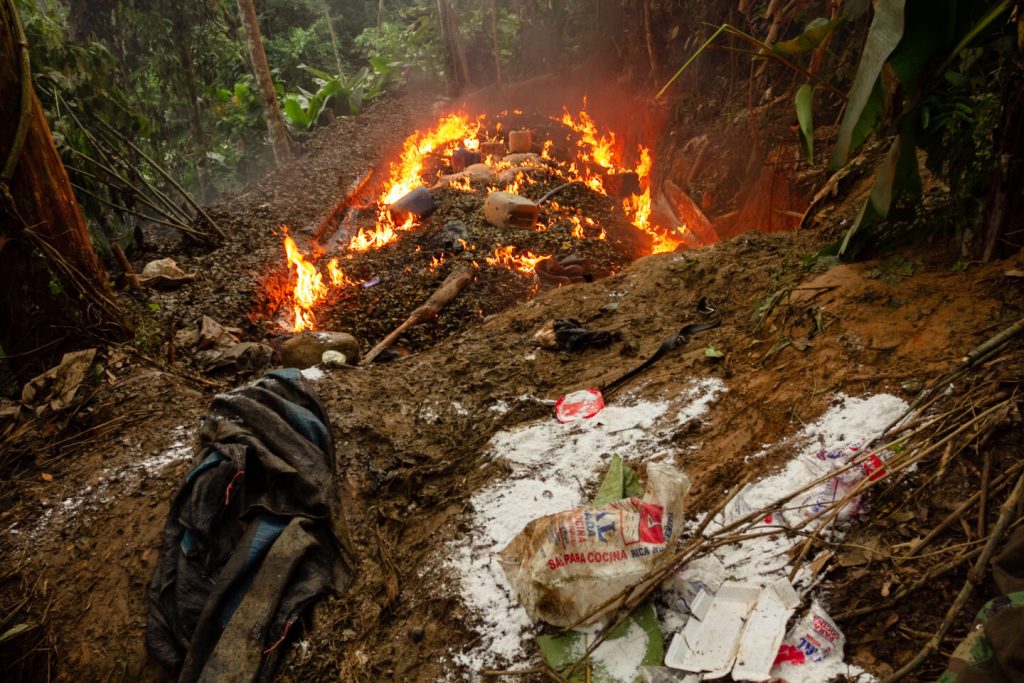
An engrossing new story published on Tuesday sheds light on the impact of Peru’s exploding cocaine trade on the country’s Indigenous people.
The story, published by Al Jazeera, opens with Fernando Aroni, a 41-year-old leader of a village of Amahuaca people, one of the Indigenous tribes in the Amazon Basin of Peru, arriving by canoe at a police outpost.
“Inside, dead bats litter the broken floorboards, and a sign on the wall bearing Peru’s national emblem, emblazoned with the words ‘God, Country and Law’ blisters and peels. The outpost stands at the 38th boundary line, a remote stretch of Amazon rainforest demarcating Peru’s border with Brazil,” the story begins.
Aroni explains that the “police checkpoint has been abandoned for over 10 years,” and that absence has been exploited by drug smugglers.
“We’ve been forgotten by the Peruvian authorities,” Aroni told Al Jazeera.
“Along the untamed edge of Peru’s Ucayali department, the cultivation of coca — the raw ingredient in cocaine — is surging. A metastasised drug trade, once concentrated within the folds of the Andes, has descended into this lowland jungle region, threatening the reserves of some of the world’s most isolated tribespeople. Narcotics experts and Indigenous communities blame an anemic state security apparatus, whose absence along its borders has created “an open door” for the accelerating drug trade…Today, as the drug trade rips through this isolated frontier, the Amahuaca — along with thousands of other remote Indigenous people — are once again in the throes of invasion.”
Cocaine trafficking in the Andean country has soared in recent years. According to Reuters, Peru “seized a record 86.4 tonnes of drugs and illicit substances last year, 28 tonnes of which were cocaine hydrochloride.” Al Jazeera reported this week that, from 2021-2022, “the land used to farm coca climbed by 18 percent, reaching record high levels” in Peru.
In March, Peruvian law enforcement seized more than two tons of cocaine –– valued at about $20 million –– that was bound for Turkey.
“This is the first incident that we know of (in which the cargo was in) Peruvian ports and its final destination was Turkey. Usually we are aware of ports in Belgium, the Netherlands, Spain and France,” said Colonel Luis Angel Bolanos, the police chief of the Peruvian port where the bust took place.
Last year, the White House Office of National Drug Control Policy (ONDCP) issued a report detailing “estimates of coca cultivation and potential cocaine production for the Republic of Colombia, the Republic of Peru, and the Plurinational State of Bolivia.”
“The Biden-Harris Administration is committed to continuing close cooperation with our partners in South America to address our shared challenge of drug production, trafficking and use,” Dr. Rahul Gupta, the director of ONDCP, said at the time. “As part of President Biden’s National Drug Control Strategy, we are pursuing policies that expand access to the continuum of care for substance use, go after drug traffickers and their profits, and also address the root causes of participation in the illicit economy in coca-growing areas, such as poverty, insecurity, and the lack of access to services.”
The report said that the U.S. “recognizes the Government of Peru’s commitment to reduce coca cultivation and cocaine production.”
“Estimated coca cultivation and cocaine production in Peru decreased but remained high at 84,400 hectares and 785 metric tons, respectively,” the report said. “The current level of coca cultivation highlights the importance of returning to pre-pandemic levels of eradication, while investing in a holistic approach that seeks to bring safety, security, and opportunity to rural Peruvians.”
Read full article on High Times

